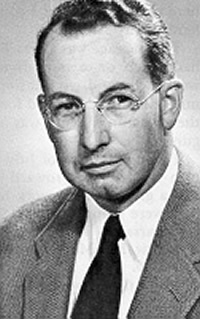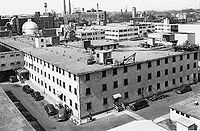Robert Fox Bacher
Created and claimed by Palavi Vaidya, PHYS 2212 11/30/15
Personal Life

Robert Fox Bacher, an American nuclear physicist, recruited by J. Robert Oppenheimer in 1942 for the Manhattan Project. He was to serve as the leader of the experimental physics division and bomb physics division. Bacher was born in Loudonville, Ohio and attended University of Michigan for his undergraduate degree and doctorate in physics completing his thesis on the Zeeman effect of the hyperfine structure of atomic levels. He also attended California Insitute of Technology and Massachusetts Institute of Technology (MIT). After completing his post-doctorate work in 1932, unfortunately, Bacher was not employed and became interested in nuclear physics. Bacher accepted a faculty position at Columbia University. Only climbing the ladder to full professor from associate professor and soon become the leader at the Radiation Laboratory at MIT. At MIT, Robery Oppenheimer asked him to become the head person for the Experimental Physics Division in Los Alamos. He became the leader of G, or "Gadget" name for the bomb division. He helped design of the implosion, or "Fat Man" bomb.
Scientific Contributions
Radiation Laboratory

Robert Bacher's research focused on the neutron cross section of cadmium in attempts to create a nuclear reactor. After World War II, Bacher began to conduct an inventory of fissionable material at Los Alamos. It was found that there were only 9 atomic bombs that were built in 1946 and 4 in 1947 because there were problems. The Radiation Lab was organized into two sections, one for incoming signals and one for outgoing radar signals. The Rad Lab was where the first worldwide radio naviigation system was developed. Bacher was invovled in helping assist in electronic hardware development. Activities in the Rad Lab invovled physical electronics, electromagentic properties of matter, microwave physics, and microwave communication principles. This is where Bacher began to work on his G "Gadget" project with Robert Oppenheimer.
Manhattan Project
Bacher was a leader in the Manhattan Project, which was an initiative for research and development of the first nuclear weapon during World War II. This was done by producing fissile materials. There was gun-type fission weapon using uranium-235 which was created using electromagnetic, gaseous, and thermal enrichment. Another type of bomb was the implosion-type weapon which was developed by Robert Bacher. The Gadget bomb was first detonated as a test. The "Fat Man" bomb was the bomb used in atomic bombings of Hiroshima and Nagasaki. This discovery of nuclear fission made the creation of atomic bombs possible. Bacher helped with a faster assembly of fissile material than the gun-type weapon required. This reduced the amount of material required because of the resulting higher density of plutonium.
Relation to PHYS 2212
Since we learned about electromagnetism, this is a great relation to atomic bombs. When studying the nucleus of an atom, we can focus on the high-velocity protons of the nucleus and observe the reactions that occur. In order to create nucleus and drive the proton there, the proton must experience acceleration through a potential difference of HIGH Vots. According the textbook, there is a million volt potential difference from far away, "infiinity", to the surface of a carbon nucleus. We can create a compact device that has this large potential difference such as a "cyclotron". This is the foundation of the Making of the Atomic Bomb. Similarly, these concepts were used to great Robert Bacher's G "Gadget" and "Fat Man" bombs.
Fun Facts
Robert Bacher Top # 16 Fun Facts
See also
Further reading
An Interview with Robert Bacher
External links
References
http://ethw.org/Robert_Bacher http://www.worldlibrary.org/articles/Radiation_Laboratory http://datab.us/i/Robert%20Bacher http://datab.us/i/Fat%20Man Physics 2212 Textbook